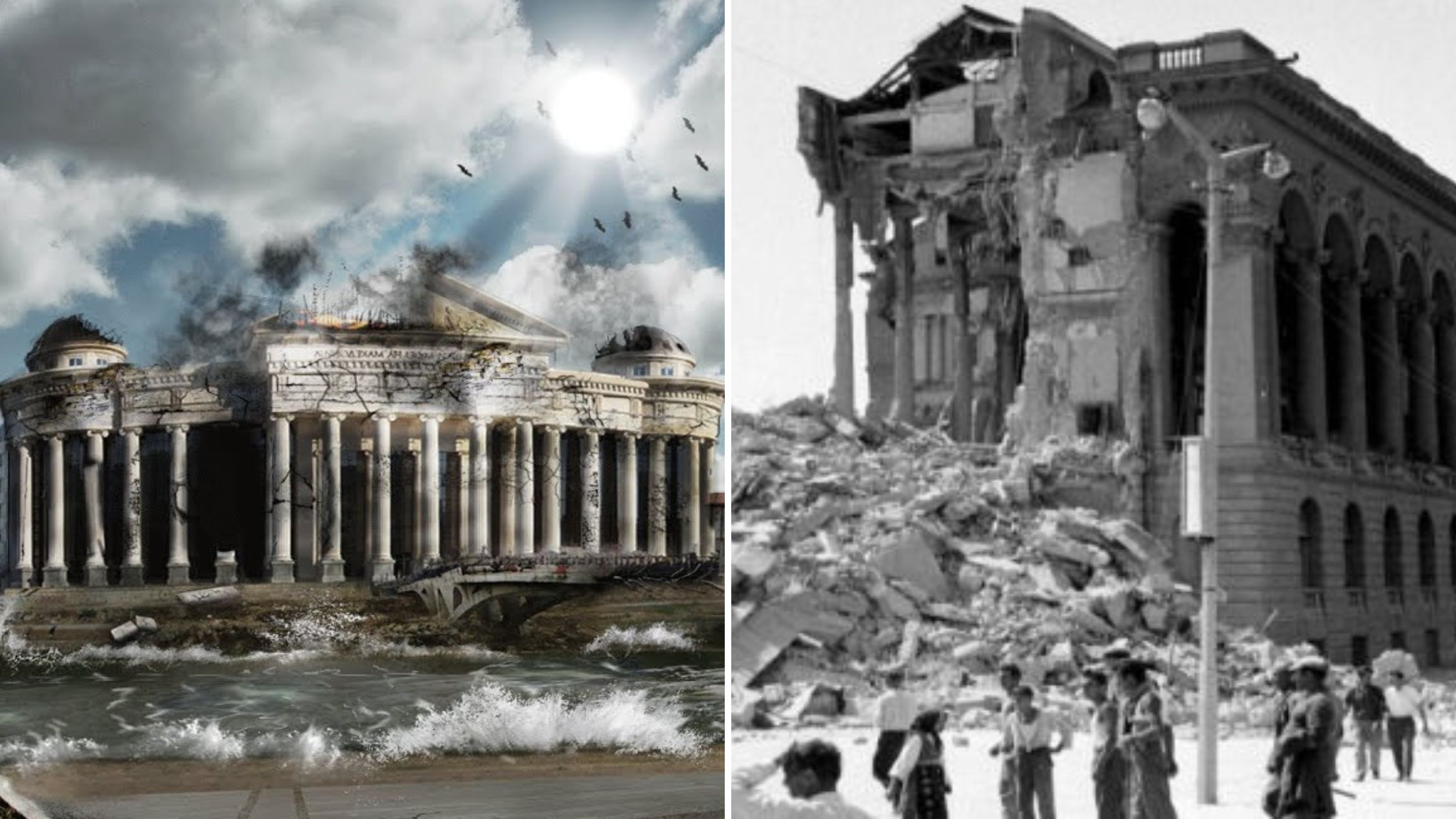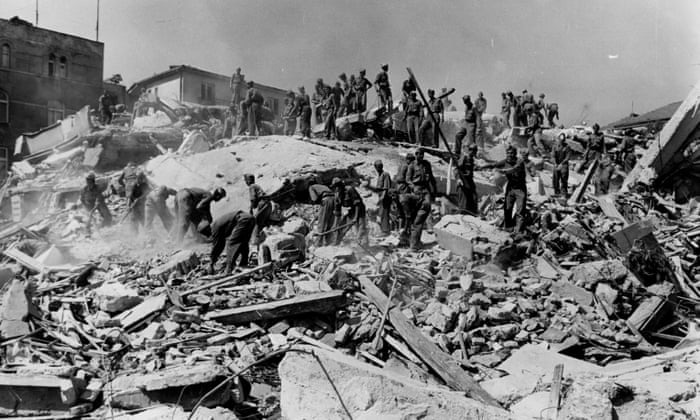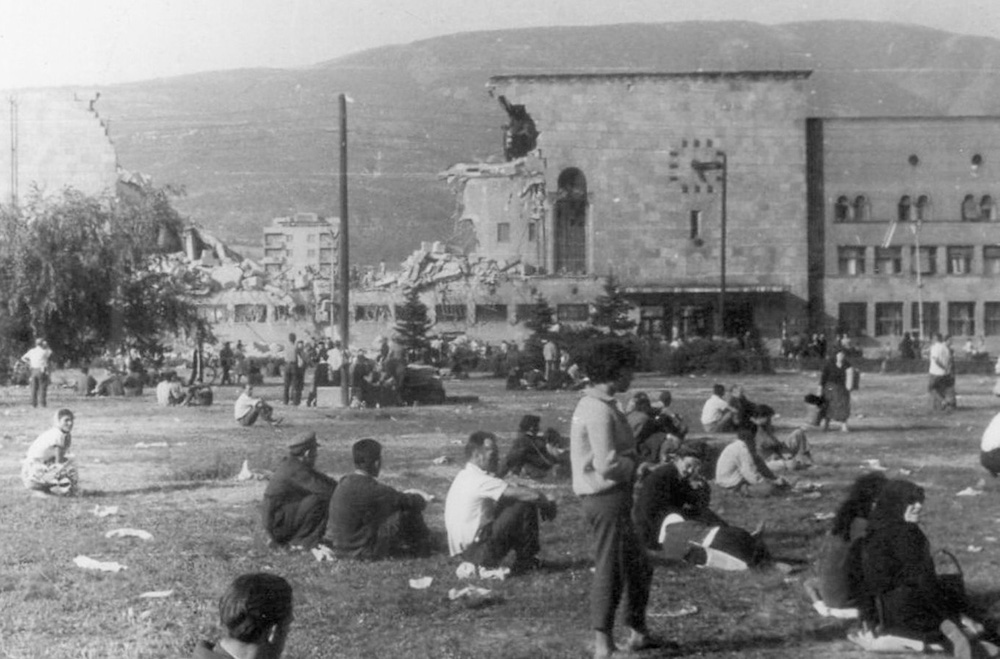The 1963 Skopje Earthquake was a momentous event in the history of the city and the region, leaving a lasting impact on the people and landscape.
On July 26, 1963, a 6.1 magnitude earthquake hit Skopje, then part of the Socialist Federal Republic of Yugoslavia and now the capital of (North) Macedonia.
The disaster resulted in the tragic loss of over 1,070 lives and injuries to between 3,000 and 4,000 people and left more than 200,000 residents homeless as approximately 80% of the city was destroyed.
In the aftermath of the earthquake, the city faced a tremendous challenge to recover and rebuild.
Aided by the support of the international community, Skopje embarked on an ambitious effort to transform the devastated city into a modern metropolis.
The rebuilding process, which included the implementation of innovative urban designs and modernist architecture, ultimately shaped Skopje’s unique appearance and identity that endures to this day.
Key Takeaways:
- The 1963 Skopje Earthquake had devastating consequences, resulting in significant loss of life, injuries, and widespread destruction.
- The post-earthquake rebuilding effort transformed Skopje into a modern city with a unique architectural character.
- International support played a crucial role in Skopje’s recovery and the development of its distinctive urban landscape.

Causes of the Earthquake
The 1963 Skopje earthquake had a magnitude of 6.1 on the moment magnitude scale.
It occurred on July 26, 1963, at 04:17 UTC (5:17 am local time) in Skopje, Socialist Republic of Macedonia, then part of SFR Yugoslavia (present-day North Macedonia) 1.
The earthquake’s epicenter was situated along the Vardar River Valley, where it was felt most strongly 2.
The main cause of the Skopje earthquake is attributed to the tectonic activity in the region.
North Macedonia is situated at the intersection of the Eurasian Plate and the Adriatic Plate, which are converging towards each other at a rate of several millimeters per year.
As a result of these tectonic forces, substantial stress builds up along various fault zones in the region, eventually causing earthquakes when the accumulated stress surpasses the strength of the rocks in the fault zones3.
In the case of the Skopje earthquake, the movement along the fault zone generated seismic waves that propagated through the ground, resulting in the destructive shaking experienced during the event.
The earthquake lasted for 20 seconds, causing widespread damage to the city 4.
An estimated 80% of the city was destroyed, leaving over 1,070 people dead and thousands more injured or homeless5.
Several factors contributed to the extensive damage caused by the Skopje earthquake.
One such factor was the type of buildings prevalent in the city at the time.
Many structures were relatively old and constructed using unreinforced masonry, which is highly susceptible to earthquake damage.
Additionally, the city’s infrastructure, such as roads, bridges, and utility systems, was also severely impacted by the shaking, making it difficult for rescue and relief efforts to take place.
Immediate Effects
The 196 earthquake resulted in about 80% of the city being destroyed, causing a significant loss of life and extensive damage to property.
Approximately 1,070 people were killed, over 3,000 individuals were injured, and around 150,000 residents were left homeless source.
Immediately after the earthquake, emergency response teams started working on search and rescue operations.
Entire neighborhoods were left in ruins, and the city’s infrastructure, such as electricity and water supply, was heavily affected.
Rescuers worked tirelessly to save lives, while the survivors were forced to cope with the harsh realities of the disaster.
In the aftermath, international aid started pouring into Skopje.
Help came from other countries, as well as from international organizations like the United Nations.
Medical assistance, food, water, and other essential supplies were provided to the affected population.
The Yugoslav president, Josip Broz Tito, expressed his condolences to the people of Macedonia and later on visited the city personally to assess the damage and extend his support.
The damage distribution in Skopje was found to be closely related to the seismic response of surficial soils.
A generally good correlation was observed between the areas with the most severe damage, the thickness of the surficial soil layer, and the predominant periods of microtremors.
Post-Earthquake Response
Emergency Assistance
The moment the 1963 Skopje earthquake struck on July 26th, emergency response teams were mobilized to provide immediate assistance to the affected areas.
The earthquake left around 1,070 people dead, over 3,000 injured, and 150,000 homeless.
Yugoslavian President Josip Broz Tito sent a message of condolences to the Socialist Republic of Macedonia and visited the city personally to assess the damage and ensure proper aid distribution.
International relief efforts were also set in motion.
Numerous countries provided humanitarian aid, financial support, and technical expertise to help Skopje recover from the disaster.
The United Nations took an active role in coordinating international assistance, which played a significant role in the city’s reconstruction process.
Reconstruction Plans
In the aftermath of the earthquake, a master plan for rebuilding Skopje was put in place.
The “City of Solidarity” project aimed to transform Skopje into a modern and functional capital that could withstand future seismic events.
A global call for architects and urban planners led to the selection of Japanese architect Kenzo Tange’s proposal.
Tange’s vision included a modernist design, divided into separate functional zones for residential, commercial, and cultural purposes.
This plan laid the foundation for Skopje’s new appearance as a symbol of progress and resilience.
Under the guidance of the United Nations, new seismic-resistant building techniques were implemented during reconstruction to ensure the city’s safety in the event of future earthquakes.
The reconstruction process offered a unique opportunity for Skopje to evolve into a city that embraced modernist architecture, symbolizing a new era for the region.
Throughout the entire recovery process, the people of Skopje displayed immense resilience and solidarity, working tirelessly to rebuild their city in the face of adversity.
The 1963 Skopje earthquake remains a crucial chapter in the city’s history and serves as an important reminder of the need for disaster preparedness and effective post-disaster response mechanisms.
International Support
Many countries sent financial aid, technical assistance, and rescue teams to help the city of Skopje recover in the aftermath of the disaster.
Among the first to offer help were the neighboring socialist countries, demonstrating solidarity among the members of the Eastern Bloc.
Experts and architects from various countries collaborated in the process of rebuilding the city, which was transformed into a modernist urban landscape.
The United Nations, through its specialized agency UNESCO, also played a significant role in coordinating international efforts for the reconstruction of Skopje.
Several fundraising events and international conferences were organized to address the earthquake’s consequences and support Skopje’s recovery, showcasing the global solidarity that emerged in response to the tragedy.
Kofi Annan, the former Secretary-General of the United Nations, recognized this in a speech he gave 40 years after the disaster.
Indeed, the 1963 Skopje earthquake is not only remembered for its devastating impact but also as an event that brought the international community together to provide support and assistance to a city in need.
This solidarity continues to serve as a reminder of the importance of global collaboration in the face of adversity.
The Long-Term Impact

Urban Planning and Architecture
The Plan for Skopje 1963 was developed by the government of Yugoslavia and the United Nations between 1963 and 1966 to rebuild and reshape the city’s urban landscape.
This plan had a lasting impact on Skopje’s architecture and urban planning.
The reconstruction campaign introduced modernist architecture to the city, transforming Skopje into a symbol of international cooperation and solidarity.
Notable examples include the City Shopping Center, the Macedonian Opera and Ballet, the Telecommunication Centre, and the main post office.
Economic Effects
The earthquake had significant economic consequences for Skopje, including significant loss of life, damage to infrastructure, and the displacement of thousands of people.
The international community, again, swiftly responded, with 35 nations requesting the United Nations General Assembly to put relief for Skopje on its agenda.
This support led to an influx of financial aid and resources aimed at facilitating the city’s recovery.
Despite the challenges faced by Skopje following the earthquake, the city experienced a remarkable resurgence, in part due to the international support and the urban planning and architectural innovations introduced through the reconstruction efforts.
The Lessons Learned

Seismic Safety Regulations
The 1963 Skopje Earthquake caused significant destruction and loss of life, highlighting the need for better seismic safety regulations.
The earthquake measured 6.1 on the moment magnitude scale and resulted in approximately 1,070 fatalities.
It destroyed 80% of the city and left 150,000 individuals homeless.
As a consequence, efforts were made to develop stronger building codes and improve the seismic resilience of Skopje’s infrastructure.
To minimize the impact of future earthquakes, the city implemented new construction standards with an emphasis on earthquake-resistant design.
Legislation was introduced to ensure all new buildings met minimum seismic performance requirements.
This led to more robust construction techniques and materials, helping to safeguard Skopje against potential earthquake-related damage.
Disaster Preparedness
The devastation experienced during the 1963 Skopje Earthquake emphasized the importance of disaster preparedness.
The earthquake struck at 5:17 in the morning, catching most residents off guard.
The need for effective emergency management plans and coordination between various stakeholders became evident following the disaster.
In response, Skopje authorities established disaster response training programs and promoted public awareness of earthquake preparedness measures.
These initiatives included educational campaigns, evacuation drills, and improved communication systems to ensure timely and accurate information dissemination during emergencies.
By implementing lessons learned from the 1963 Skopje Earthquake, the city has significantly improved its seismic safety regulations and disaster preparedness.
These efforts reflect a commitment to protecting citizens and minimizing future catastrophes.
What was the magnitude of the 1963 Skopje Earthquake?
The 1963 Skopje Earthquake had a moment magnitude of 6.1.
It struck Skopje, then part of the Socialist Federal Republic of Yugoslavia, and now present-day North Macedonia, causing significant destruction and loss of life.
How many victims were there in the 1963 Skopje Earthquake?
The earthquake resulted in over 1,070 fatalities, with approximately 3,000 to 4,000 injured.
In addition to the loss of life, around 150,000 people were left homeless due to the widespread damage.
Where was the epicenter of the 1963 Skopje Earthquake?
The epicenter of the 1963 Skopje Earthquake was located at 42.10° N latitude and 21.40° E longitude.
This placed the epicenter near Skopje in present-day North Macedonia.
What was the impact of the earthquake on Skopje’s infrastructure?
The earthquake caused extensive damage to Skopje’s infrastructure, with around 80% of the city destroyed.
The destruction left many buildings and structures in ruins, and essential services like water, power, and transportation were severely disrupted.
What was the timeline for rebuilding Skopje after the 1963 earthquake?
The rebuilding process commenced soon after the earthquake, with planning and reconstruction efforts taking priority.
Much of Skopje was redesigned and rebuilt with the help of international architects and engineers, adopting modernist principles and styles that transformed the city into what is now known as the “City of Solidarity”.
- https://en.wikipedia.org/wiki/1963_Skopje_earthquake
- https://www.spomenikdatabase.org/post/skopje-s-1963-quake-from-ruins-to-modernist-resurrection
- https://www.wikiwand.com/en/1963_Skopje_earthquake
- https://en.wikipedia.org/wiki/1963_Skopje_earthquake
- https://www.spomenikdatabase.org/post/skopje-s-1963-quake-from-ruins-to-modernist-resurrection
- https://www.discoveringmacedonia.com/2019/the-skopje-earthquake-a-devastating-catastrophe/
This guide was first published on July 26, 2023 and was last updated on March 15, 2024. For more information, please contact us at contact@skopjeguide.com.